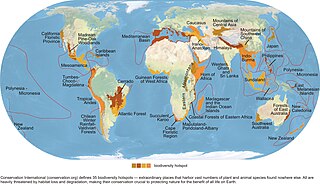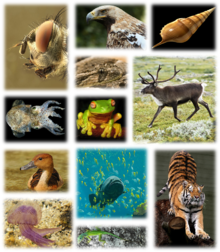
The Holocene extinction, or Anthropocene extinction, is the ongoing extinction event caused by humans during the Holocene epoch. These extinctions span numerous families of plants and animals, including mammals, birds, reptiles, amphibians, fish, and invertebrates, and affecting not just terrestrial species but also large sectors of marine life. With widespread degradation of biodiversity hotspots, such as coral reefs and rainforests, as well as other areas, the vast majority of these extinctions are thought to be undocumented, as the species are undiscovered at the time of their extinction, which goes unrecorded. The current rate of extinction of species is estimated at 100 to 1,000 times higher than natural background extinction rates and is increasing. During the past 100–200 years, biodiversity loss and species extinction have accelerated, to the point that most conservation biologists now believe that human activity has either produced a period of mass extinction, or is on the cusp of doing so. As such, after the "Big Five" mass extinctions, the Holocene extinction event has also been referred to as the sixth mass extinction or sixth extinction; given the recent recognition of the Capitanian mass extinction, the term seventh mass extinction has also been proposed for the Holocene extinction event.

Biodiversity or biological diversity is the variety and variability of life on Earth. Biodiversity is a measure of variation at the genetic, species, and ecosystem level. Biodiversity is not distributed evenly on Earth; it is usually greater in the tropics as a result of the warm climate and high primary productivity in the region near the equator. Tropical forest ecosystems cover less than 10% of earth's surface and contain about 90% of the world's species. Marine biodiversity is usually higher along coasts in the Western Pacific, where sea surface temperature is highest, and in the mid-latitudinal band in all oceans. There are latitudinal gradients in species diversity. Biodiversity generally tends to cluster in hotspots, and has been increasing through time, but will be likely to slow in the future as a primary result of deforestation. It encompasses the evolutionary, ecological, and cultural processes that sustain life.

Extinction is the termination of a taxon by the death of its last member. A taxon may become functionally extinct before the death of its last member if it loses the capacity to reproduce and recover. Because a species' potential range may be very large, determining this moment is difficult, and is usually done retrospectively. This difficulty leads to phenomena such as Lazarus taxa, where a species presumed extinct abruptly "reappears" after a period of apparent absence.

Conservation biology is the study of the conservation of nature and of Earth's biodiversity with the aim of protecting species, their habitats, and ecosystems from excessive rates of extinction and the erosion of biotic interactions. It is an interdisciplinary subject drawing on natural and social sciences, and the practice of natural resource management.

Habitat conservation is a management practice that seeks to conserve, protect and restore habitats and prevent species extinction, fragmentation or reduction in range. It is a priority of many groups that cannot be easily characterized in terms of any one ideology.

The Anthropocene is a proposed geological epoch dating from the commencement of significant human impact on Earth's geology, landscape, limnology and ecosystems, including, but not limited to, anthropogenic climate change. The nature of the effects of human activities on Earth can be seen for example in biodiversity loss, climate change, biogeography and nocturnality parameters, changes in geomorphology and stratigraphy.
An ecological or environmental crisis occurs when changes to the environment of a species or population destabilizes its continued survival. Some of the important causes include:

Habitat destruction occurs when a natural habitat is no longer able to support its native species. The organisms once living there have either moved to elsewhere or are dead, leading to a decrease in biodiversity and species numbers. Habitat destruction is in fact the leading cause of biodiversity loss and species extinction worldwide.

Human impact on the environment refers to changes to biophysical environments and to ecosystems, biodiversity, and natural resources caused directly or indirectly by humans. Modifying the environment to fit the needs of society is causing severe effects including global warming, environmental degradation, mass extinction and biodiversity loss, ecological crisis, and ecological collapse. Some human activities that cause damage to the environment on a global scale include population growth, neoliberal economic policies and rapid economic growth, overconsumption, overexploitation, pollution, and deforestation. Some of the problems, including global warming and biodiversity loss, have been proposed as representing catastrophic risks to the survival of the human species.

Wildlife conservation refers to the practice of protecting wild species and their habitats in order to maintain healthy wildlife species or populations and to restore, protect or enhance natural ecosystems. Major threats to wildlife include habitat destruction, degradation, fragmentation, overexploitation, poaching, pollution, climate change, and the illegal wildlife trade. The IUCN estimates that 42,100 species of the ones assessed are at risk for extinction. Expanding to all existing species, a 2019 UN report on biodiversity put this estimate even higher at a million species. It is also being acknowledged that an increasing number of ecosystems on Earth containing endangered species are disappearing. To address these issues, there have been both national and international governmental efforts to preserve Earth's wildlife. Prominent conservation agreements include the 1973 Convention on International Trade in Endangered Species of Wild Fauna and Flora (CITES) and the 1992 Convention on Biological Diversity (CBD). There are also numerous nongovernmental organizations (NGO's) dedicated to conservation such as the Nature Conservancy, World Wildlife Fund, the Wild Animal Health Fund and Conservation International.

In biology, a refugium is a location which supports an isolated or relict population of a once more widespread species. This isolation (allopatry) can be due to climatic changes, geography, or human activities such as deforestation and overhunting.

The Tropical Andes is northern of the three climate-delineated parts of the Andes, the others being the Dry Andes and the Wet Andes. The Tropical Andes' area spans 1,542,644 km2 (595,618 sq mi).

There are several plausible pathways that could lead to an increased extinction risk from climate change. Every plant and animal species has evolved to exist within a certain ecological niche. But climate change leads to changes of temperature and average weather patterns. These changes can push climatic conditions outside of the species' niche, and ultimately render it extinct. Normally, species faced with changing conditions can either adapt in place through microevolution or move to another habitat with suitable conditions. However, the speed of recent climate change is very fast. Due to this rapid change, for example cold-blooded animals may struggle to find a suitable habitat within 50 km of their current location at the end of this century.

Insect biodiversity accounts for a large proportion of all biodiversity on the planet—over half of the estimated 1.5 million organism species described are classified as insects.

Defaunation is the global, local, or functional extinction of animal populations or species from ecological communities. The growth of the human population, combined with advances in harvesting technologies, has led to more intense and efficient exploitation of the environment. This has resulted in the depletion of large vertebrates from ecological communities, creating what has been termed "empty forest". Defaunation differs from extinction; it includes both the disappearance of species and declines in abundance. Defaunation effects were first implied at the Symposium of Plant-Animal Interactions at the University of Campinas, Brazil in 1988 in the context of Neotropical forests. Since then, the term has gained broader usage in conservation biology as a global phenomenon.
In ecology, extinction debt is the future extinction of species due to events in the past. The phrases dead clade walking and survival without recovery express the same idea.

Biodiversity loss happens when various species disappear completely from Earth (extinction) or when there is a decrease or disappearance of species in a specific area. This in turn leads to a reduction in biological diversity in that area. The decrease can be temporary or permanent. It is temporary if the damage that has led to the loss is reversible in time, for example through ecological restoration. If this is not possible then the decrease is permanent. This ongoing global extinction is a biodiversity crisis. The cause for most of the biodiversity loss are those human activities that push the planetary boundaries too far.
Conservation paleobiology is a field of paleontology that applies the knowledge of the geological and paleoecological record to the conservation and restoration of biodiversity and ecosystem services. Despite the influence of paleontology on ecological sciences can be traced back at least at the 18th century, the current field has been established by the work of K.W. Flessa and G.P. Dietl in the first decade of the 21st century. The discipline utilizes paleontological and geological data to understand how biotas respond to climate and other natural and anthropogenic environmental change. These information are then used to address the challenges faced by modern conservation biology, like understanding the extinction risk of endangered species, providing baselines for restoration and modelling future scenarios for species range's contraction or expansion.
The Global Assessment Report on Biodiversity and Ecosystem Services is a report by the Intergovernmental Science-Policy Platform on Biodiversity and Ecosystem Services, on the global state of biodiversity. A summary for policymakers was released on 6 May 2019. The report states that, due to human impact on the environment in the past half-century, the Earth's biodiversity has suffered a catastrophic decline unprecedented in human history, as an estimated 82 percent of wild mammal biomass has been lost. The report estimates that there are 8 million animal and plant species on Earth, with the majority represented by insects. Out of those 8 million species, 1 million are threatened with extinction, including 40 percent of amphibians, almost a third of reef-building corals, more than a third of marine mammals, and 10 percent of all insects.
The Biodiversity of South Africa is the variety of living organisms within the boundaries of South Africa and its exclusive economic zone. South Africa is a region of high biodiversity in the terrestrial and marine realms. The country is ranked sixth out of the world's seventeen megadiverse countries, and is rated among the top 10 for plant species diversity and third for marine endemism.


















